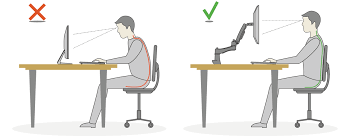Laptop vs. Desktop: The Ergonomic Pros and Cons of Each
- Christopher nour

- Apr 24
- 2 min read
Whether you’re working from home, the office, or a café, your choice of computer setup can significantly impact your posture, comfort, and long-term musculoskeletal health. While laptops are convenient and portable, desktops are often seen as more ergonomic—but is that really the case?
Here’s a breakdown of the pros and cons of laptops versus desktops from an ergonomic perspective, along with practical advice to help you optimise your workstation—no matter what you use.
Laptops: Convenient but Compromising
Pros:
Highly portable for flexible work environments
Compact and ideal for smaller workspaces
Quick to set up for short tasks or mobile work
Cons:
Screen and keyboard are fixed, forcing awkward posture
Encourages hunching, forward head posture, and shoulder rounding
Limited adjustability without accessories
Laptops are designed for convenience, not ergonomics. Using one on its own often results in poor posture—especially when used for long periods. The most common issues include neck and upper back pain, tight shoulders, and wrist strain.
Ergonomic Tips for Laptop Users:
Elevate your laptop on a stand or a stack of books to bring the screen to eye level
Use an external keyboard and mouse to maintain neutral wrist and shoulder positions
Take movement breaks every 30 to 60 minutes to reset your posture
Desktops: Ergonomic by Design (If Set Up Properly)
Pros:
Separate monitor, keyboard, and mouse allow proper positioning
Easier to adjust for optimal posture
Better suited for long work hours
Cons:
Not portable
Requires more space
Still prone to poor posture if not set up correctly
A desktop setup provides more opportunity for ergonomic alignment, but it must be properly adjusted. Monitor height, chair positioning, and arm support all play a role in reducing strain on the neck, shoulders, and lower back.
Ergonomic Tips for Desktop Users:
Position the top third of your monitor at eye level
Keep the monitor at arm’s length
Sit with elbows at 90 degrees and feet flat on the floor or on a footrest
Ensure your chair supports your lower back and encourages an upright posture
Comparison Overview
Feature | Laptop | Desktop |
Portability | Excellent | Not portable |
Ergonomic adjustability | Limited (without accessories) | Highly adjustable |
Ideal for long work hours | Not recommended | Suitable with correct setup |
Space requirements | Minimal | Requires dedicated space |
Risk of poor posture | High without modification | Lower with proper setup |
Choosing the Right Setup for You
Use a laptop if:
You work on the go or switch locations often
You have limited space, but are willing to invest in accessories
Use a desktop if:
You work in a fixed location and want a posture-friendly setup
You need higher computing power or work long hours at a desk
Best of both worlds:Use a laptop with a full desktop-style workstation when at home or in the office—complete with an external monitor, keyboard, and mouse.




Comments